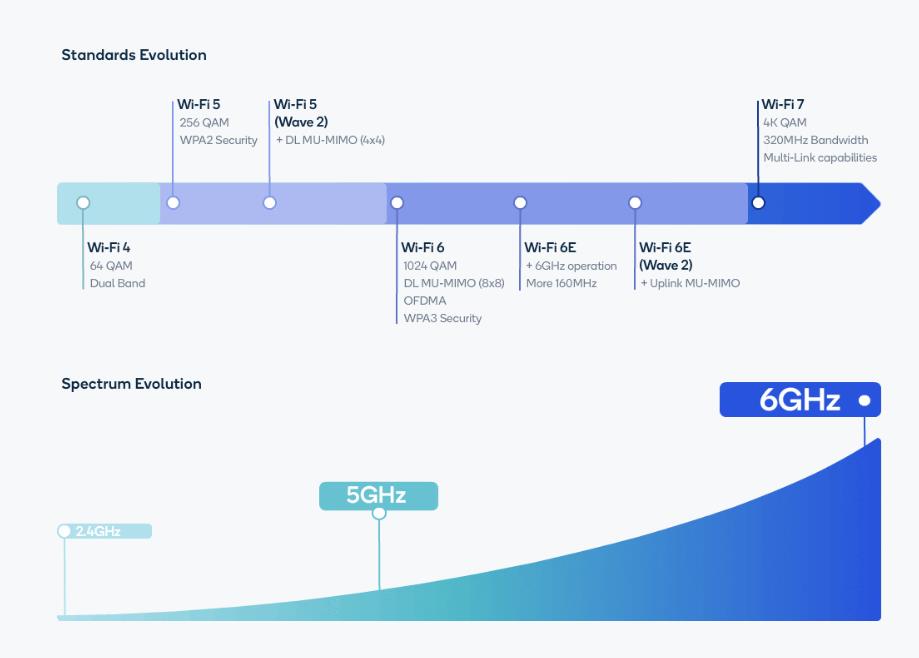IPQ9574 QCN9274 |WiFi 7 solution|Wallystech
Wireless networking technology has come a long way since the first WiFi standard was introduced in 1997. Over the years, we've seen significant improvements in speed, range, and reliability, as well as the introduction of new features like beamforming and MU-MIMO. And now, the next big step in wireless networking is on the horizon: WiFi 7.
What is WiFi 7?
WiFi 7, also known as IEEE 802.11be, is the upcoming wireless networking standard that promises to take wireless performance to the next level. While the standard has not yet been officially ratified, many companies are already working on developing WiFi 7 technology that will push the boundaries of what is possible with wireless networking.
One of the key features of WiFi 7 is its ability to use multiple frequency bands, including 2.4GHz, 5GHz, and 6GHz. This enables faster speeds and more reliable connections, as well as the ability to support more devices simultaneously.
In addition, WiFi 7 is expected to leverage advanced technologies like OFDMA (Orthogonal Frequency Division Multiple Access) and MU-MIMO (Multi-User Multiple Input Multiple Output) to maximize capacity, decrease latency, and increase speed. This will enable a wide range of new use cases, including low-latency extended reality (XR), social cloud-based gaming, 8K video streaming, and simultaneous video conferencing and casting.
Benefits of WiFi 7
WiFi 7 promises to deliver a range of benefits that will enhance the wireless networking experience for users. Some of the key benefits include:
Extreme Wireless Speeds: WiFi 7 is expected to deliver speeds of up to 30 Gbps, which is significantly faster than previous WiFi standards. This means that users will be able to download and upload large files quickly and easily.
Low Latency: With advanced technologies like OFDMA and MU-MIMO, WiFi 7 promises to reduce latency and improve network performance. This is especially important for applications like online gaming and video conferencing, where even a small delay can be noticeable.
Improved Range: WiFi 7 is expected to use advanced beamforming and antenna technologies to provide better coverage and range, even in large homes or outdoor areas.
Advanced Management and Control: WiFi 7 will incorporate advanced management and control features, including AI and machine learning, to optimize network performance and improve user experiences.
Enhanced Security: WiFi 7 will support the latest security protocols, including WPA3 and Enhanced Open, to better protect users and their data.
Overall, WiFi 7 promises to be a significant step forward in wireless networking technology. While it may be a few years before we see widespread adoption of the standard, the potential benefits for users are clear. Whether you're a gamer, a video streamer, or just someone who wants the fastest and most reliable wireless network possible, WiFi 7 is something to keep an eye on.
One of the key players in the WiFi 7 space is Qualcomm, a leading provider of wireless technology solutions. Qualcomm's IPQ9574 and QCN9274 chip is one of the first to support WiFi 7, and it promises to deliver enhanced speeds, latency, and network capacity, along with advanced features like 320MHz channels, 4K QAM, and High Band Simultaneous Multi-Link.
But while the chip itself is impressive, it's not enough on its own to provide the kind of high-quality wireless communication that businesses and consumers are looking for. That's where companies like WallysTech come in.
WallysTech specializes in providing industrial wireless communication solutions, including industrial wifi modules, routerboards, antennas, and more. With a strong focus on WiFi, WallysTech is well-positioned to help businesses take advantage of the latest wireless technology, including WiFi 7.
What sets WallysTech apart is its experienced software and hardware engineering team. With software engineers who have over 10 years of experience working with QCA wifi chips, WallysTech is well-equipped to help customers resolve WiFi-related issues and develop special protocols that can improve performance. Additionally, WallysTech has extensive knowledge of Qualcomm chips, which allows them to optimize drivers, achieve anti-interference and long-distance performance, and help customers develop various wireless functions.

For businesses that need high-quality industrial wireless communication solutions, WallysTech is a strong choice. With a focus on WiFi and a team of experienced engineers, WallysTech can help customers take advantage of the latest wireless technology, including WiFi 7. By working with companies like Qualcomm to develop cutting-edge chips and leveraging their expertise to develop customized solutions, WallysTech is helping to shape the future of wireless communication.
Email:sales1@wallystech.com
Website: https://www.wallystech.com/





















 249
249











 被折叠的 条评论
为什么被折叠?
被折叠的 条评论
为什么被折叠?








